
Expected to spend a few brief hours at Swedish Days in Geneva, Illinois yesterday -- down a little kringle, admire the Lutheran ladies’ rosemahling, wander through the vendors’ stalls and then head on home for a nap. But things took a turn when we went looking for the Viking ship.
The Viking was built in Norway just a few brief years after the gorgeous Gokstad was unearthed in Norway in 1880 -- a stunning wooden ship that was probably built around 890 A.D. and is now housed in the Viking Ship Museum in Oslo.

Chicago, being brash Chicago, suggested that Norway should send over the precious artifact, thinking it would be cool to display it during the World's Fair in 1893. Norway wisely said no. But some Norwegians got the idea that it would be equally cool to build a replica and sail it across the Atlantic to Chicago. (Crazy Norwegians.) So that’s what they did.
The Viking sailed from Bergen, Norway to Chicago in time for the World’s Fair, and was met at each port, our guide told us, by Scandinavian immigrants waving flags and offering free meals. It did a brief tour after the Fair down the Mississippi to New Orleans, and then sat and moldered for a long while after that in Lincoln Park, and today is undergoing extensive renovations in the skilled hands of master boat builders under a big tarp in Good Templar Park in Geneva.
And here is where our story begins.
After a whole lot of hunting we found the park which was difficult to track down because it wasn’t situated like you would expect a city park to be -- reason being: it’s not a city park.
Good Templar Park is a privately-owned Temperance Park, established by the International Organization of Good Templars in the early 1900s to provide Swedes with a teetotalling alternative to the raucous Swedish Days which were then being conducted up at Ravinia.
We bought tickets, which seemed steep at ten bucks, and wandered over to the Viking ship tent, poked around under the canvas and circled the stripped down hull. I took some shots of plumb lines and rusted screws and grumbled about how much cooler the real one is in Oslo while we waited for our guide to get started.
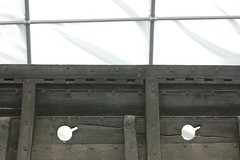
The guide, a retired school teacher full of heart, did a great job of redeeming the hull, telling us about its construction and its passage and its restoration -- and how excited the kids get when they come to visit. But the real prize came unexpectedly when we were handed off to another fellow for the “Cottage Tour”.
Turns out there are 52 small cottages nestled away in Good Templar Park, built from between the park’s inception until today, hidden in the understory of ancient high-arching hard woods. Cottages are still being built, albeit according to strict guidelines ordained by the park’s residents. Cottage owners own the cottage only -- the Good Templars own the park land.
Our guide took us into the shady recesses of the park and through a few of the cottages: Most of them clapboard, one stunner made of rough hewn logs, the majority still populated with the early cast iron or propane stoves that were installed when the cottages were first constructed.
We crisscrossed a dry stream bed on foot bridges built by residents and descended at one point into a hollow on a staircase made of rough cherry wood and birch trees that had fallen during a storm in the park.
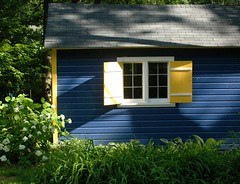
The cottages are occupied by their residents from late spring through early fall and none of them have true toilets -- they all share a common washhouse in the center of the park, near the Meeting House -- although a few have installed chamber pot like thrones and one matriarch has an electric toilet: “the pride of the park” we were told.
To own a cottage in Good Templar Park one must be, in fact, a good Templar, and sign an oath to abstain from alcohol and illegal drugs. The Good Templars were heavily invested in America’s Temperance Movement and eventual Prohibition, and are still proud of the fact that their little park remains a dry pocket in an inebriated world.
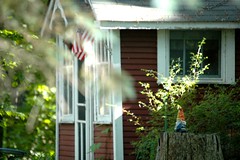
The few residents we met were sweet souled folk and generous, to let us tromp through their summer homes. One gentleman greeted us on his stoop with a formal welcome that he wrote out by hand on paper torn from a spiral binder; another cottage owner took us on a story-rich detailed tour of all the “Scandinavian Art” that she cherishes (painted plates and textiles; straw creatures and LED-lit battery operated candelabras).
Tellingly, there was evidence in each conversation that this place in the woods was their safe place.
It’s impossible to speak of safety, of course, without implying its opposition -- danger -- and the residents that we met bore that tender bruised look of folks who had been hurt by addiction: Either theirs or another’s. Adding to the sense that we were walking through a place of refuge were the little garden gnomes (like the little fellow in Amelie) who stood sentry around nearly every home.
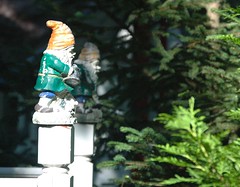
If you’re of Scandinavian descent -- and the majority of the residents at Good Templar are of Swedish or Norwegian ancestry -- you know that that these gnomes are called Tomtes or Nisses, and are fiercely protective (and vindictive) house spirits who resist change and will ensure the safety of your home so long as you follow the rules and provide the proper attentions. (Porridge with a pat of butter served after dark is one.)
I’ve always dismissed garden gnomes as tchotkes, but I couldn’t dismiss them at Good Templar. They were of such abundance and variety -- peering out from door stoops and through windows -- it was as if they were breeding in the woods.
There was something solemn in their presence that reminded me of the pride of place given to Spirit Houses in Thailand, used to attract benevolent spirits, through offerings and sufficient shelter, to look after the home and its residents and to keep them (the spirits) out of trouble.
David, our guide and, we soon came to learn, an influential committee member who has a say in who’s let into ownership in the park and who’s not -- said to us as we first approached the park: “The only change to come to Good Templar will be evolutionary, not revolutionary” and you could feel it in every shady grove of that place: The invitation -- and perhaps the expectation -- to sit down for coffee with friends; to share some pastries and talk about the world. Talk about the way it is; the way it always will be.
To simply sit and be.
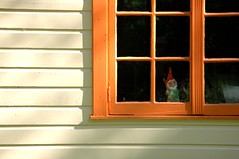
Good Templar conducts Cottage Tours only twice a year, two weekends in a row, starting with Father's Day weekend and extending through Geneva's Swedish Day celebration. They're also holding a summer concert series -- and lucky for you I grabbed a flyer with this season's schedule:
The Midway Ramblers Cajun Band
August 2nd
Phil Cooper and margaret Nelson
August 23rd
Charlotte Madeline
September 27th
Tickets are $10 each unless you're a member of the International Organization of the Good Templars -- then you get a discount. Call 847-845-2640 for yours, or show up at the gate at 528 East Side Drive in Geneva, Illinois.






2 comments:
Great post, D. Hope you saw the mention on Gapers Block too :-)
Well, if I'm going to be a good Norwegian, I think I need to get a gnome now. What a great post, my friend. Thanks for the lovely tour.
Post a Comment